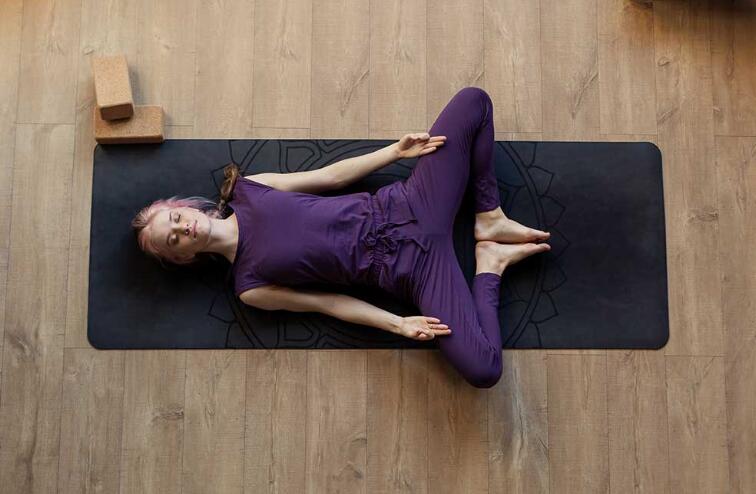Yoga has been found to be a valuable tool for athletes in terms of physical and mental preparedness. On the physical side, yoga can improve flexibility, core strength, and balance—all of which are important components of any athlete’s skill set. Studies have also shown that regular yoga practice can reduce injuries and improve overall muscular endurance.
In this article, we will explore the link between yoga and improved athletic performance. We’ll look at how yoga can help athletes prepare for competition, stay in shape, and reduce their risk of injury. We’ll also discuss some of the more popular postures used by athletes and provide some tips for getting started with a regular yoga practice.
The science behind yoga and athletic performance

Yoga is a discipline that has been around for thousands of years. Its benefits have long been recognized by those who practice it. Yoga can contribute to physical fitness as well as mental and emotional wellbeing.
Improved flexibility and range of motion
Yoga is known for improving flexibility and range of motion. Practicing yoga helps to stretch out the muscles in your body and maintain flexibility. This is beneficial to athletes who need to maintain a wide range of motion for their sport. A flexible body is less prone to injury compared to one that is stiff. Yoga also helps to lengthen the muscles, which can lead to a better alignment of the body, thereby improving posture and reducing pain.
Increased strength and endurance
Yoga is not just about stretching and relaxing, it also involves holding poses that require strength. This makes yoga an excellent way to build functional strength throughout the entire body. Unlike traditional strength training exercises that target specific muscles, yoga demands full-body engagement and builds endurance. Improved strength and endurance can help athletes perform at their best, whether in a competition or everyday life.
Better balance and coordination
Yoga requires a great deal of concentration and is known to improve balance and coordination. This is particularly beneficial to athletes who need to maintain balance, such as runners, dancers, and gymnasts. A regular yoga practice can help improve the connection between the mind and body, leading to better focus and balance in all areas of life.
Reduced stress and anxiety
Athletes deal with a lot of pressure, both physical and mental. Practicing yoga can help to reduce the levels of stress and anxiety. Yoga helps to stimulate the parasympathetic nervous system, which induces relaxation and calmness. A regular yoga practice can help athletes manage stress and anxiety more effectively, leading to improved performance.
Improved focus and concentration
Yoga involves a great deal of concentration and focus. The practice of yoga requires one to be fully present in the moment. This level of concentration and focus can translate to all areas of life, including athletic performance. By practicing yoga, athletes can learn to concentrate better, which can help them focus on their performance and block out external distractions.
Enhanced self-awareness
Yoga helps to improve self-awareness by encouraging introspection and reflection. For athletes, this means having a better understanding of themselves and their body. Athletes who practice yoga can better recognize their own limitations, strengths, and weaknesses. This can help improve their performance by allowing them to listen to their bodies and make informed decisions about training and rest.
Techniques for Incorporating Yoga into Athletic Training

Athletic training is a physically demanding activity that takes a toll on an athlete’s body. To avoid injuries, it’s essential to create a balance between intense workouts and recovery.
1. Suggestions for How to Integrate Yoga into Existing Training Regimes
The most common challenge athletes face when integrating yoga into their training regime is finding the time and energy to practice. One way to overcome this obstacle is to view yoga as a recovery activity instead of a workout. Incorporate yoga into your rest days or off-season, when the intensity of your training is lower, and your recovery needs are higher.
Another option is to incorporate short yoga routines before or after your workouts. This approach can help improve flexibility and aid muscle recovery. Consider incorporating yoga poses that target specific muscle groups, such as pigeon pose for hips, Cobra pose for back strength, or chair pose for lower body engagement.
2. Tips for Creating a Balanced Yoga Practice That Complements Other Training Activities
Balance is key when incorporating yoga into a training program. It’s essential to create a yoga routine that complements your other activities so that you can maintain a healthy balance between strength, flexibility, and recovery. Start with five to ten minutes of sun salutations to warm up your body, then move into poses that will focus on your strengths and weaknesses.
For example, if you’re a runner, focus on poses that target the hamstrings, quads, and hips. If you’re a weightlifter, focus on poses that engage the core and upper body. Try to practice yoga at least three times a week, and incorporate both active and passive stretching to create balance within your routine.
3. Analysis of Successful Case Studies of Athletes Who Have Incorporated Yoga into Their Training
Many athletes have successfully integrated yoga into their training regime. Olympic swimmer Michael Phelps used yoga to reduce stress and balance his training schedule while improving flexibility. NFL players like Victor Cruz and Vernon Davis practice yoga to improve their flexibility and prevent injuries. Similarly, pro wrestler Triple H incorporated yoga into his training regimen to improve his balance and agility.
These athletes found that yoga provided a range of benefits, from improved flexibility and injury prevention to reduced stress and improved recovery time. By incorporating yoga into their training schedule, they were able to create a more balanced and effective program that supported their overall physical and mental health.
Conclusion
Athletes around the world are beginning to realize the importance of incorporating yoga into their training regimens. By adding yoga to their existing regimes, athletes can experience a wide range of physical and mental benefits that can improve performance and reduce the risk of injury.
